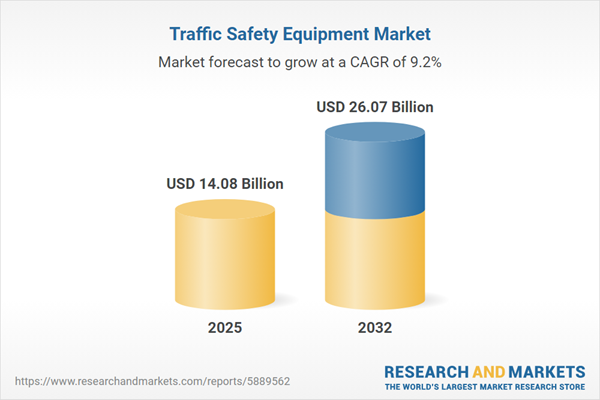Speak directly to the analyst to clarify any post sales queries you may have.
The Traffic Safety Equipment Market is experiencing rapid transformation as automotive safety technologies advance and regulatory landscapes shift worldwide. This report delivers actionable insights to help senior leaders understand evolving opportunities, manage emerging risks, and set informed strategic priorities amidst complex global trends.
Market Snapshot: Traffic Safety Equipment Market Growth and Outlook
The Traffic Safety Equipment Market grew from USD 12.87 billion in 2024 to USD 14.08 billion in 2025. It is projected to continue expanding at a CAGR of 9.22%, reaching USD 26.07 billion by 2032. The market’s trajectory reflects heightened demand for intelligent safety systems, stricter regulatory requirements, and the increasing complexity of supply chains and technology partnerships in the automotive sector.
Scope & Segmentation
This report provides a comprehensive analysis of the traffic safety equipment industry, covering critical product segments, end uses, installation preferences, regions, and distribution channels:
- Product: Airbags (front, knee, side), Antilock Braking Systems (four-wheel, two-wheel), Collision Avoidance Systems (automatic emergency braking, forward collision warning), Electronic Stability Control, Lane Departure Warning Systems (alert, lane keeping assist), Seat Belts (inflatable, mechanical and pyrotechnic pretensioners, three-point)
- End Use: Commercial vehicles (buses, heavy and light commercial vehicles), Passenger cars (hatchback, sedan, SUVs), Two wheelers
- Installation: Aftermarket (component distributors, repair shops, retail outlets), OEM (car manufacturers, Tier 1 suppliers)
- Distribution Channel: Offline (independent workshops, OEM dealerships, specialty stores), Online (direct sales, e-commerce platforms)
- Geographic Coverage: Americas (United States, Canada, Mexico, Brazil, Argentina, Chile, Colombia, Peru), Europe, Middle East & Africa (including the UK, Germany, France, Russia, Italy, Spain, Gulf states, South Africa), Asia-Pacific (China, India, Japan, Australia, South Korea, Southeast Asia, Taiwan, Singapore)
- Company Coverage: Analysis includes key players such as 3M Company, Swarco AG, Avery Dennison Corporation, Brady Worldwide, Inc., Siemens Mobility GmbH, Econolite Group, Inc., Kapsch TrafficCom AG, Iteris, Inc., Trelleborg AB, and Lindsay Corporation
Key Takeaways for Decision-Makers
- The convergence of automotive hardware with software and sensor technologies is reshaping competitive dynamics, requiring industry participants to build capabilities in electronics, data analytics, and machine vision.
- Rising global regulatory expectations are accelerating adoption of integrated systems, raising the baseline for vehicle safety features and driving cross-industry collaboration in development and deployment.
- Ongoing trade measures and tariffs, particularly in the US, are impacting supply chain configurations, leading to increased regional sourcing and the need for resilient procurement and logistics strategies.
- Product differentiation is broad, with safety offerings customized for vehicle class, region, and usage scenario—requiring tailored product portfolios and flexible distribution strategies for market leaders.
- Aftermarket channels, supported by digital platforms and enhanced logistics, are growing in importance, opening access to underserved segments and enabling rapid response to evolving regulatory mandates.
Tariff Impact: Adapting to Shifting Trade Policies
Recent United States tariffs on imported automotive components have changed cost structures, prompting manufacturers to shift toward regional supply bases and explore dual-sourcing models. This environment has stimulated value engineering in component design and encouraged innovation in procurement, warehousing, and logistics services. Companies relying on specialty components increasingly partner with local suppliers and semiconductor foundries to mitigate operational volatility, even at higher landed costs.
Methodology & Data Sources
Research for this report combined extensive literature review, structured interviews with industry executives, and analysis of government regulations and technical standards. Quantitative and qualitative data were triangulated for reliability, with findings corroborated through industry publications, conference proceedings, and patent filings.
Why This Report Matters
- Equips executive teams with a clear view of competitive, regulatory, and supply chain dynamics impacting the traffic safety equipment sector.
- Enables informed decision-making on investment, product development, and partnership strategies to achieve sustainable growth and risk mitigation.
- Presents actionable insights tailored for organizations seeking to align product, operational, and regional strategies with rapidly evolving market demands.
Conclusion
This report highlights the interplay of technology innovation, regulatory change, and supply chain adaptation in the traffic safety equipment market. Senior decision-makers will gain valuable context and clarity to chart sustainable strategies in a rapidly evolving sector.
Additional Product Information:
- Purchase of this report includes 1 year online access with quarterly updates.
- This report can be updated on request. Please contact our Customer Experience team using the Ask a Question widget on our website.
Table of Contents
3. Executive Summary
4. Market Overview
7. Cumulative Impact of Artificial Intelligence 2025
Companies Mentioned
The companies profiled in this Traffic Safety Equipment market report include:- 3M Company
- Swarco AG
- Avery Dennison Corporation
- Brady Worldwide, Inc.
- Siemens Mobility GmbH
- Econolite Group, Inc.
- Kapsch TrafficCom AG
- Iteris, Inc.
- Trelleborg AB
- Lindsay Corporation
Table Information
| Report Attribute | Details |
|---|---|
| No. of Pages | 196 |
| Published | November 2025 |
| Forecast Period | 2025 - 2032 |
| Estimated Market Value ( USD | $ 14.08 Billion |
| Forecasted Market Value ( USD | $ 26.07 Billion |
| Compound Annual Growth Rate | 9.2% |
| Regions Covered | Global |
| No. of Companies Mentioned | 11 |









